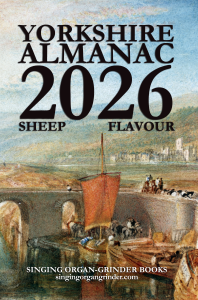2 January 1883: Wilson Barrett premières a pantomime version of Yorkshire hero Robinson Crusoe at the Grand, Leeds
George Lancaster. 1883/01/01. Notes on the Pantomimes. Theatre. Ed. Clement Scott. London: David Bogue. Get it:
.Excerpt
From the depths below the sea, the scene changes to a beautiful view of the Port of Hull, where the hero’s adventures commence. One mechanical change rapidly follows another, until we find ourselves on the full-set deck of Crusoe’s vessel. The storm rises, the ship sinks beneath the waves, and Crusoe is seen on the raft riding safely on the calm sea in the tropical moonlight, and steering for the distant island. The other characters are rescued in various ways, and, when upon the island and among the savages, their adventures follow each other in fast and furious fashion. Crusoe’s hut is besieged by the cannibals, the walls are blown down, and Crusoe and his party escape in canoes, being, however, vigorously pursued by the cannibal king and his myrmidons. The scene of “The Golden Island,” by Mr Stafford Hall, is spoken of as a beautiful stage picture; and in this scene the procession, with its enormous and striking properties, its crowds of barbaric warriors and Amazons, and its glow of colour, will no doubt be the talk of all Yorkshire. The remaining scenes show how the villainy of Will Atkins is defeated; how Crusoe is rescued from the power of his savage foes by the military might of Great Britain; how the cannibal king is brought to England (à la Cetewayo [Zulu king exiled in London 1879-83]); and how the nuptials of Crusoe and his sweetheart Polly are celebrated in a locality which all Yorkshiremen will recognize. With merry song and dance and comic incident the story runs along gaily to the end, when Mr Louis Edouarde’s magnificent transformation scene – founded on the legend of Paradise and the Peri – gives the crowning touch to Mr Barrett’s fifth annual at the Grand Theatre and his eighth in Leeds.
Comment
Comment
Date. There is no reference to performances before the announcement in the Leeds Mercury on Monday 1883/1/1 of a 2 p.m. show that same day.
“Paradise and the Peri” is a tale in Lalla Rookh by Thomas Moore.
Something to say? Get in touch
Original
Mr. Wilson Barrett’s forthcoming pantomime for the Grand Theatre, Leeds, is an entirely new version of the story of “Robinson Crusoe,” the libretto being, as usual, written by Mr. J. Wilton Jones. The preparations have been going on for several months past, and various eminent scenic artists have been busily engaged, including Mr. Walter Hann, Mr. Bruce Smith, Mr. Stafford Hall, Mr. Louis Edouarde, and Mr. Johnson. The scenic and mechanical effects are said to be highly novel and ingenious. From the depths below the sea, the scene changes to a beautiful view of the Port of Hull, where the hero’s adventures commence. One mechanical change rapidly follows another, until we find ourselves on the full-set deck of Crusoe’s vessel. The storm rises, the ship sinks beneath the waves, and Crusoe is seen on the raft riding safely on the calm sea in the tropical moonlight, and steering for the distant island. The other characters are rescued in various ways, and, when upon the island and among the savages, their adventures follow each other in fast and furious fashion. Crusoe’s hut is besieged by the cannibals, the walls are blown down, and Crusoe and his party escape in canoes, being, however, vigorously pursued by the cannibal king and his myrmidons. The scene of “The Golden Island,” by Mr. Stafford Hall, is spoken of as a beautiful stage picture; and in this scene the procession, with its enormous and striking “properties,” its crowds of barbaric warriors and amazons, and its glow of colour, will no doubt be the talk of all Yorkshire. The remaining scenes show how the villany of Will Atkins is defeated; how Crusoe is rescued from the power of his savage foes by the military might of Great Britain; how the cannibal king is brought to England (à la Cetewayo); and how the nuptials of Crusoe and his sweetheart Polly are celebrated in a locality which all Yorkshiremen will recognize. With merry song and dance and comic incident the story runs along gaily to the end, when Mr. Louis Edouarde’s magnificent transformation scene – founded on the legend of “Paradise and the Peri” – gives the crowning touch to Mr. Barrett’s fifth annual at the Grand Theatre and his eighth in Leeds. The dresses throughout have been designed by M. Wilhelm. The company is an exceptionally strong one. Miss Fannie Leslie, who made such a hit as Crusoe at Drury Lane last year, has been specially engaged to play the title rôle, and the other performers include Mr. H. D. Burton, Mr. H. C. Arnold, Chirgwin, the “White-Eyed Kaffir,” the Brothers Griffiths, the entire Lupino family of pantomimists, Miss Kissie Wood, Miss Grace Whiteford, and numerous other performers of more or less note. Mr. Wilson Barrett’s liberality in catering for his patrons at the Grand increases year by year, and this time his efforts bid fair to eclipse all that have gone before.
496 words.
Similar
Search
Donate
Music & books
Place-People-Play: Childcare (and the Kazookestra) on the Headingley/Weetwood borders next to Meanwood Park.
Music from and about Yorkshire by Leeds's Singing Organ-Grinder.


 Bluesky
Bluesky Extwitter
Extwitter